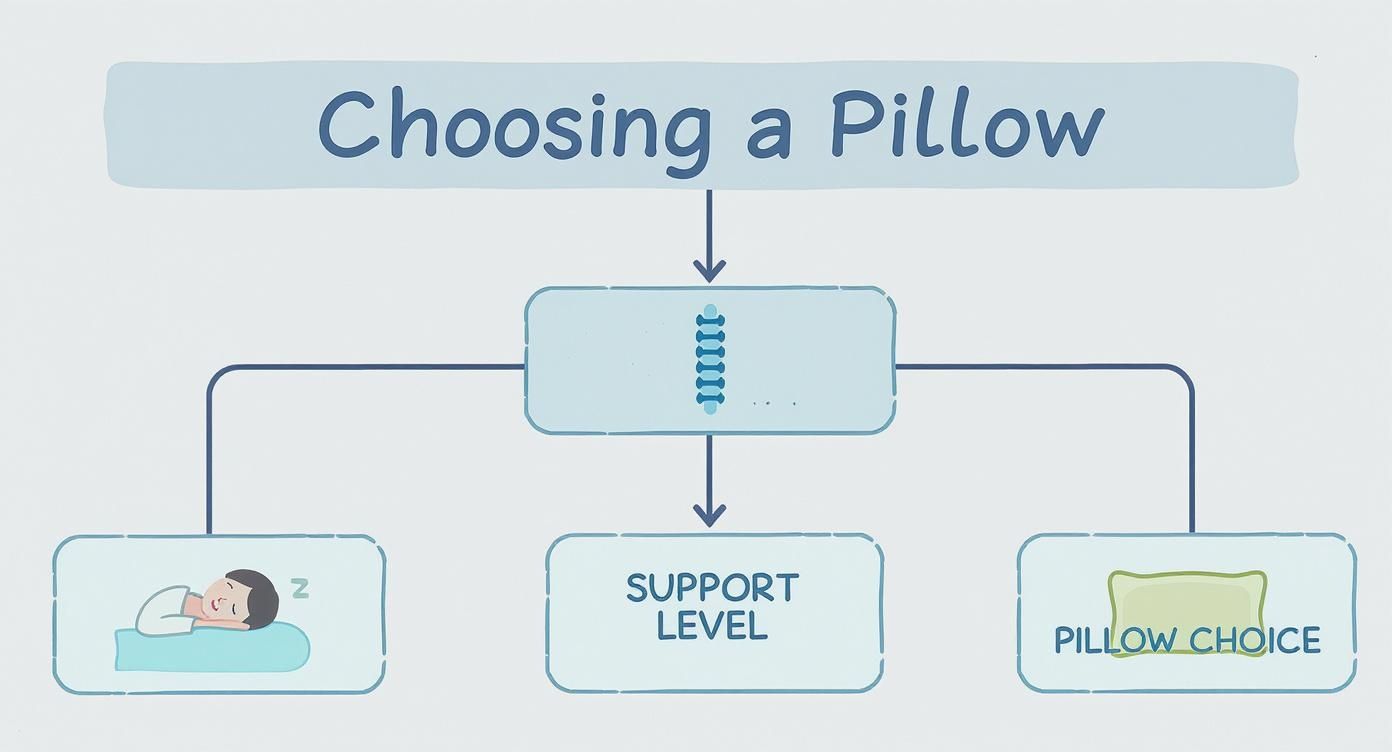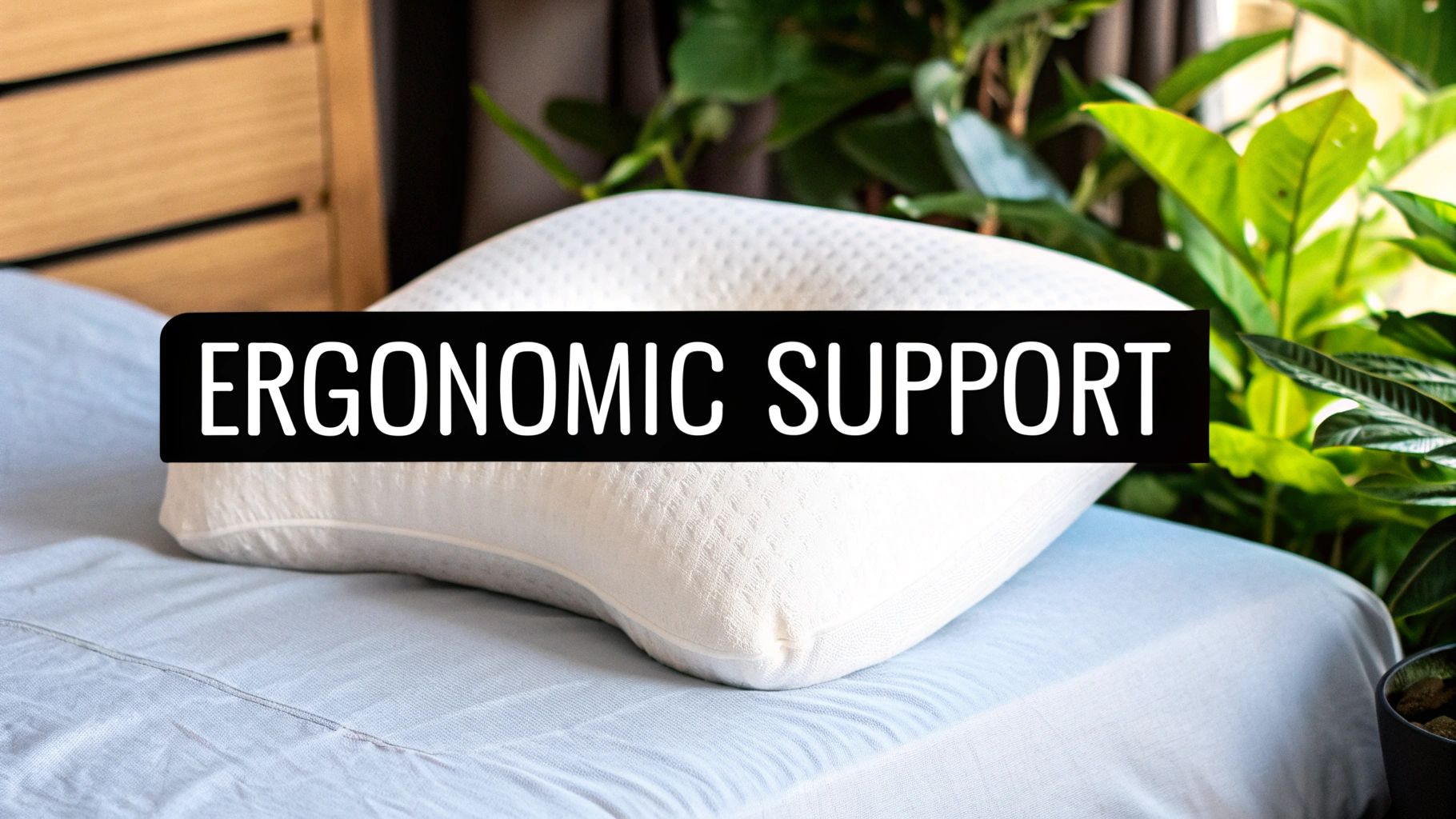Let's be honest—choosing a new pillow often feels like a complete guessing game. Most of us just grab whatever feels softest in the store, only to end up with a sore neck and restless nights. The good news is you can skip the frustrating trial and error.
The key is to realise a pillow’s job isn’t just about comfort; it’s a critical tool for your sleep health.
A great pillow has one main purpose: to keep your head, neck, and spine in a straight, neutral line while you sleep. This prevents the unnatural bending that leads to muscle strain, stiffness, and even those nagging morning headaches. A mismatched pillow forces your neck into an awkward angle for hours on end, completely undoing the benefits of a good mattress.
This guide is your practical roadmap to making a much better choice. We’ll walk through the most important factors to consider, including:
- Your go-to sleep position: This is hands-down the most important thing to figure out first.
- Pillow fill materials: From memory foam to down, each one offers a totally different feel and level of support.
- Loft and firmness: This is all about how high and dense your pillow needs to be for perfect alignment.
By the end, you'll have the know-how to confidently browse our extensive range of pillows and pick one that actually supports your long-term health, not just your head for a night or two.
A study on sleep quality found that a pillow with proper cervical support can significantly reduce neck pain and improve how rested you feel. It’s not just about softness; it’s about structure and alignment.
Aligning Your Pillow with Your Sleep Position
How you sleep is the single most important clue to finding the right pillow. The goal is simple: keep your head, neck, and spine in a straight, neutral line. A pillow that’s too high or too low will force your neck into an awkward curve, and that’s a fast track to stiffness and pain.
Think of your pillow as the bridge filling the space between your head and the mattress. The size of that gap is determined entirely by your go-to sleeping position.
For the Side Sleepers
If you’re a side sleeper, you’ve got the biggest gap to fill—the space between your ear and the outside of your shoulder. This means you need a pillow with more height, or loft, and a firmer structure to stop your head from dipping down during the night. A firm, high-loft pillow is what keeps your spine aligned all the way from your neck down your back.
For the Back Sleepers
Sleeping on your back is all about finding a delicate balance. You need enough support to maintain the natural curve of your neck, but not so much that it pushes your head forward, crunching your chin towards your chest. That position doesn't just strain your muscles; it can even mess with your breathing. A medium-loft, medium-firm pillow is usually the sweet spot.
Key Takeaway: The perfect pillow for a back sleeper cradles the head and supports the neck without causing any upward or downward tilt. It should feel almost weightless.
This decision tree shows exactly how your sleep style points to the right support level and pillow choice.

As you can see, matching the loft and firmness to your position is the first and most crucial step for proper spinal alignment.
For the Stomach Sleepers
Stomach sleepers face the biggest challenge because this position naturally puts a lot of stress on the spine. Your best bet is often a very thin, soft pillow—or sometimes, no pillow at all. The aim here is to keep your head as level with the mattress as possible to minimise the twist in your neck.
Getting this right is crucial for waking up refreshed. You can learn more about finding the correct pillow for neck and back support in our detailed guide, which dives deeper into these ideas. A simple adjustment based on how you sleep can make a world of difference.
What’s Actually Inside Your Pillow?
The stuff inside your pillow is what gives it its personality—from that cloud-like softness you sink into, to the firm support that keeps your neck happy. It’s easy to just grab one off the shelf, but looking past the packaging is the secret to finding a pillow that actually lasts and does its job.
Let's get into the most common materials you'll find.

Pillow Fill Material Comparison
To make things a bit easier, here’s a quick rundown of the most popular pillow fillings. This table breaks down what they feel like, what they’re good at, and who they’re best for, so you can see at a glance what might work for you.
| Material | Feel & Support | Pros | Cons | Best For |
|---|---|---|---|---|
| Down & Feather | Soft, plush, and mouldable. You can scrunch it up just how you like. | Luxurious feel, long-lasting with good care, very breathable. | Can trigger allergies, requires regular fluffing, support can be inconsistent. | Stomach sleepers and those who love a classic, hotel-style pillow. |
| Memory Foam | Dense and contouring. It moulds to your shape with slow, pressure-relieving support. | Excellent neck and head support, holds its shape, great for alignment. | Can retain heat, feels firm to some, slow to respond to movement. | Side and back sleepers needing consistent, firm support. |
| Latex | Bouncy and responsive with a soft-yet-supportive feel. | Naturally hypoallergenic, durable, very breathable and cool. | Can be heavy and expensive, has a distinct bouncy feel that's not for everyone. | Hot sleepers and people who change positions often. |
| Polyester/Microfibre | Lightweight and soft, often mimics the feel of down for a lower price. | Hypoallergenic, affordable, easy to wash and care for. | Flattens quickly, offers minimal support, not very breathable. | Budget-conscious shoppers and guest bedrooms. |
Hopefully, that gives you a clearer picture. Now, let's dive a little deeper into the main players.
Traditional Fills: Down and Feathers
When you think of a classic, luxurious pillow, you’re probably thinking of down and feathers. They give you that sink-in softness that so many people love. Down provides the plush, airy loft, while the feathers add a bit more substance and support.
The best thing about them is their mouldability. You can bunch them up, flatten them out, and shape them exactly how you need throughout the night.
My Tip: A good way to check the quality of a down pillow is to give it a good fluff. High-quality down will bounce back and regain its loft almost instantly. If it stays compressed or feels lumpy, it’s likely a lower-quality fill.
Modern and Responsive Fills
Memory foam has become a huge favourite, and for good reason. Its real strength is the way it contours to the exact shape of your head and neck, offering consistent, pressure-relieving support. This makes it a brilliant choice if you need stable alignment, especially for back and side sleepers. You can learn more about the surprising benefits of a memory foam pillow right here on our blog.
Another material that’s really taken off is natural latex. Sourced from rubber trees, latex pillows are known for being incredibly durable, breathable, and naturally hypoallergenic. Unlike memory foam’s slow sink, latex has a much more buoyant and responsive feel, springing back into shape almost immediately. This is a game-changer if you toss and turn a lot.
The Growing Pillow Market in Australia
It's clear that Aussies are paying more attention to sleep wellness, because the pillow market here is booming. In 2022, the market pulled in around USD 513.6 million, with feather and down pillows still holding the biggest slice of the pie.
But the real story is in the growth. Latex pillows are the fastest-growing segment, which shows just how many people are now looking for natural and allergy-friendly options. The whole market is projected to nearly double by 2030, which tells you everything you need to know about how much we value a good night's rest.
It's also worth thinking about the bigger picture when you buy. Looking into sustainable fabric choices for your pillow can help you make a decision that feels good in more ways than one, from the fill right through to the cover.
When to Consider an Ergonomic Pillow
If you’re waking up with a stiff neck, a nagging ache in your shoulder, or even tension headaches day after day, your standard pillow might be the culprit. While regular pillows are all about general comfort, ergonomic pillows are different. They're specialised tools, engineered to solve specific alignment problems.
They aren't just unusually shaped for the sake of it. Think of an ergonomic pillow as an investment in your sleep wellness. Each curve and contour is there for a reason—to promote optimal spinal posture while you rest. A perfect example is a cervical pillow, which has a contoured dip designed to cradle your head and support the natural curve of your neck. It’s fantastic for back and side sleepers who need that extra structure to keep everything aligned.

Identifying the Need for a Change
So, how do you know if you need to make the switch? Your body usually tells you first thing in the morning. Pay attention to those signals.
- Persistent Neck Stiffness: If your neck feels tight or locked every morning, your current pillow is likely failing to give you proper support through the night.
- Shoulder or Arm Discomfort: This is a big one for side sleepers. If your pillow is too low, your shoulder can collapse inward, leading to pain or that annoying pins-and-needles feeling in your arm.
- Restless Nights: Constantly tossing and turning to get comfortable is a clear sign your head and neck aren't properly supported.
It's no surprise that more and more people are looking for solutions. This growing awareness around sleep health is driving serious interest in specialised pillows. In the Asia Pacific region, including Australia, the ergonomic pillow market is projected to grow from USD 317.9 million in 2021 to an estimated USD 429.5 million by 2025. This surge is fuelled by people just like you, seeking real relief from posture-related sleep issues. You can explore more data on this trend by reading the full ergonomic pillow market report.
Choosing the right ergonomic design is crucial. A chiropractor can offer personalised advice, and many of the pillows recommended by chiropractors are designed to address these very specific alignment issues, helping you finally achieve a pain-free morning.
You’ve done the heavy lifting and figured out what sleep style and fill suits you best. Now, it's time for the final details—the little things that take a pillow from 'good enough' to 'perfect'. Getting these right ensures you're not just comfortable, but also getting real value for your money.
First up, let’s talk size. A standard pillow might be fine for a single or double bed, but pop it on a king mattress and it'll look a bit lost. More than just aesthetics, it means less coverage for you. The simple rule is to match your pillow size to your mattress—queen pillows for a queen bed, king for a king. It creates a bed that looks balanced and feels just right.
Cooling Tech and Allergy Considerations
If you’re a hot sleeper, this part is for you. Don't just skim past features designed for temperature regulation, because they can be a game-changer. Look out for things like gel-infused foams, breathable Tencel covers, or even perforated latex. These aren't just marketing buzzwords; they genuinely help dissipate heat and can make a massive difference if you often wake up feeling overheated.
For anyone with sensitivities or allergies, a hypoallergenic pillow isn't just a nice-to-have, it's a must. Materials like latex and memory foam are naturally resistant to dust mites. Many synthetic fills are also specifically treated to stop allergens from building up. Just make sure to check the product description for a "hypoallergenic" label to guarantee a sneeze-free night.
A pillow protector is your best friend for hygiene. It creates a barrier against dust mites, moisture, and allergens, extending the life of your pillow and keeping it fresh.
Check the Fine Print and Plan for the Future
The Australian pillow market is growing fast, and with so many of us shopping online, retailers have had to step up. To meet our demands for better health and comfort, you'll find more and more brands offering decent trial periods and return policies. I'd recommend looking for at least a 30-night trial. It gives your body proper time to adjust and takes the risk out of being stuck with a pillow that just isn’t working for you.
Finally, think about the long haul. A great pillow is just one part of the puzzle. Keeping all your bedding in top shape is key to lasting comfort—from understanding how to properly care for your duvet to knowing when it's time for a refresh. Even the best pillows don't last forever, so check out our guide on replacing and maintaining your pillows to know when it's time for an upgrade.
Common Questions About Choosing a Pillow
Even after you've nailed down your sleep style and favourite materials, a few last questions usually pop up. Getting these sorted is the final step to feeling confident you've made the right choice, so let's clear up some of the most common things we hear from shoppers.
How Often Should I Replace My Pillow?
The general rule of thumb is to replace your pillow every 1-2 years. Over time, even the best pillows lose their supportive structure and become a hotspot for allergens like dust mites and dead skin cells. As they break down, they stop doing their main job: keeping your spine properly aligned.
Not sure if it's time? Try the fold test. Fold your pillow in half. If it doesn’t spring back into shape, its support system has officially retired. It’s definitely time for an upgrade.
Can a Better Pillow Help with Snoring?
In many cases, yes. Snoring often happens when your airway is partially blocked while you sleep. A pillow that puts your head and neck in the correct position helps to keep that passage open, which can lead to clearer, quieter breathing all night.
Expert Tip: If you're a back sleeper who snores, a contoured cervical pillow can be a real game-changer. It’s designed to cradle the neck and stops your chin from dropping towards your chest—a position known to make snoring worse.
Should I Use More Than One Pillow?
When it comes to sleeping, you should only ever use one pillow under your head. Stacking pillows might feel cosy at first, but it almost always pushes your neck into an unnatural, strained angle. This completely defeats the purpose of finding a supportive pillow in the first place.
That said, using extra pillows for body support is a fantastic idea. For side sleepers, placing a firm pillow between the knees helps align the hips and lower back, taking off pressure and making a huge difference to your overall comfort.
Ready to find the perfect pillow without all the guesswork? Explore the full collection at Manchester Factory and discover options designed for every type of sleeper. Shop our extensive range of supportive pillows today!

